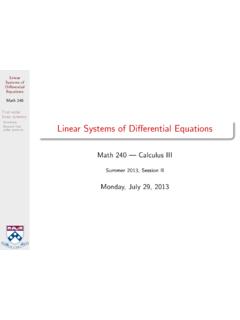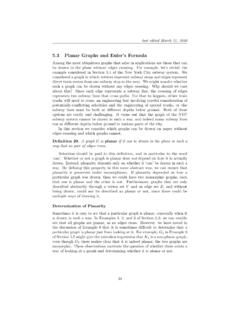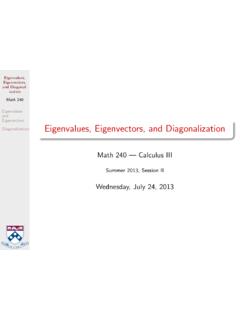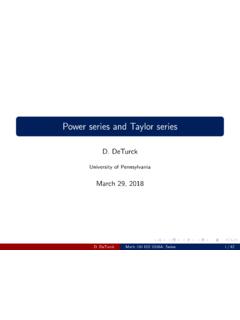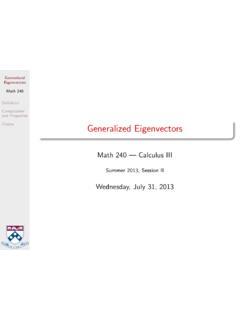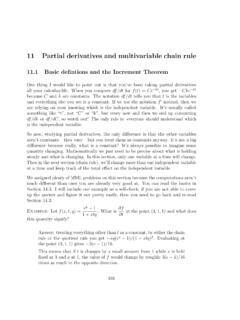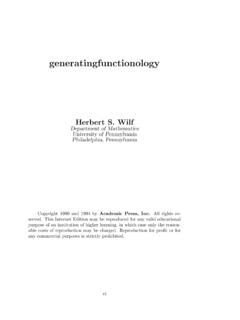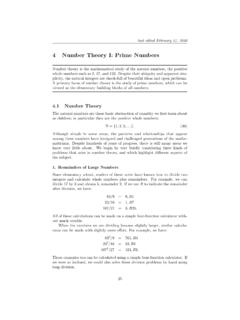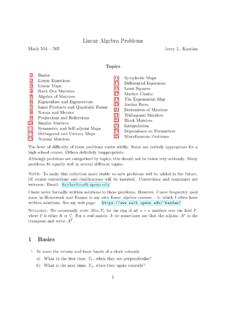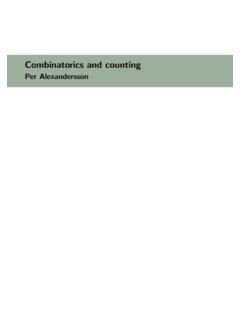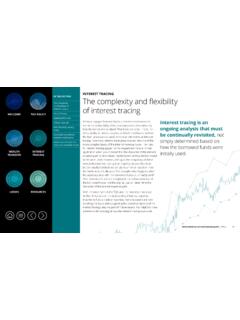Transcription of Algorithms and Complexity - University of Pennsylvania
1 Algorithms and ComplexityHerbert S. WilfUniversity of PennsylvaniaPhiladelphia, PA 19104-6395 Copyright NoticeCopyright 1994 by Herbert S. Wilf. This material may be reproduced for any educational purpose, multiplecopies may be made for classes, etc. Charges, if any, for reproduced copies must be just enough to recoverreasonable costs of reproduction. Reproduction for commercial purposes is prohibited. This cover page mustbe included in all distributed Edition, Summer, 1994 This edition of Algorithms and Complexity is available at the web site<http:// wilf>.It may be taken at no charge by all interested persons. Comments and corrections are welcome, and shouldbe sent Second Edition of this book was published in 2003 and can be purchased now. The Second Edition containssolutions to most of the 0: What This Book Is.
2 Hard vs. easy problems ..4 Chapter 1: Mathematical Orders of magnitude .. Positional number systems .. Manipulations with series .. Recurrence relations .. 24 Chapter 2: Recursive .. Recursive graph Algorithms .. Fast matrix multiplication .. The discrete Fourier transform .. Applications of the FFT .. 60 Chapter 3: The Network Flow .. Algorithms for the network flow problem .. The algorithm of Ford and Fulkerson .. The max-flow min-cut theorem .. The Complexity of the Ford-Fulkerson algorithm .. The MPM Algorithm .. Applications of network flow .. 77 Chapter 4: Algorithms in the Theory of Preliminaries .. The greatest common divisor .. The extended Euclidean algorithm .. Primality testing .. Interlude: the ring of integers Pseudoprimality tests.
3 Proof of goodness of the strong pseudoprimality test .. Factoring and cryptography .. Factoring large integers .. Proving primality .. 100iiiChapter 5: .. Turing machines .. Cook s theorem .. Some other NP-complete problems .. Backtracking (I): independent sets .. Backtracking (II): graph coloring .. Approximate Algorithms for hard problems .. 128ivPrefaceFor the past several years mathematics majors in the computing track at the University of Pennsylvaniahave taken a course in continuous Algorithms (numerical analysis) in the junior year, and in discrete algo-rithms in the senior year. This book has grown out of the senior course as I have been teaching it has also been tried out on a large class of computer science and mathematics majors, including seniorsand graduate students, with good by the instructor of topics of interest will be very important, because normally I ve foundthat I can t cover anywhere near all of this material in a semester.
4 A reasonable choice for a first try mightbe to begin with Chapter 2 (recursive Algorithms ) which contains lots of motivation. Then, as new ideasare needed in Chapter 2, one might delve into the appropriate sections of Chapter 1 to get the conceptsand techniques well in hand. After Chapter 2, Chapter 4, on number theory, discusses material that isextremely attractive, and surprisingly pure and applicable at the same time. Chapter 5 would be next, sincethe foundations would then all be in place. Finally, material from Chapter 3, which is rather independentof the rest of the book, but is strongly connected to combinatorial Algorithms in general, might be studiedas time the book there are opportunities to ask students to write programs and get them are not mentioned explicitly, with a few exceptions, but will be obvious when encountered.
5 Studentsshould all have the experience of writing, debugging, and using a program that is nontrivially recursive,for example. The concept of recursion is subtle and powerful, and is helped a lot by hands-on of the Algorithms of Chapter 2 would be suitable for this purpose. The recursive graph Algorithms areparticularly recommended since they are usually quite foreign to students previous experience and thereforehave great learning addition to the exercises that appear in this book, then, student assignments might consist of writingoccasional programs, as well as delivering reports in class on assigned readings. The latter might be foundamong the references cited in the bibliographies in each am indebted first of all to the students on whom I worked out these ideas, and second to a num-ber of colleagues for their helpful advice and friendly criticism.
6 Among the latter I will mention RichardBrualdi, Daniel Kleitman, Albert Nijenhuis, Robert Tarjan and Alan Tucker. For the no-doubt-numerousshortcomings that remain, I accept full book was typeset in TEX. To the extent that it s a delight to look at, thank TEX. For the deficienciesin its appearance, thank my limitations as a typesetter. It was, however, a pleasure for me to have had thechance to typeset my own book. My thanks to the Computer Science department of the University ofPennsylvania, and particularly to Aravind Joshi, for generously allowing me the use of TEX S. WilfvChapter 0: What This Book Is BackgroundAn algorithm is a method for solving a class of problems on a computer. The Complexity of an algorithmis the cost, measured in running time, or storage, or whatever units are relevant, of using the algorithm tosolve one of those book is about Algorithms and Complexity , and so it is about methods for solving problems oncomputers and the costs (usually the running time) of using those takes time.
7 Some problems take a very long time, others can be done quickly. Some problemsseemto take a long time, and then someone discovers a faster way to do them (a faster algorithm ). Thestudy of the amount of computational effort that is needed in order to perform certain kinds of computationsis the study of , we would expect that a computing problem for which millions of bits of input data arerequired would probably take longer than another problem that needs only a few items of input. So the timecomplexity of a calculation is measured by expressing the running time of the calculationas a function ofsome measure of the amount of data that is needed to describe the problem to the instance, think about this statement: I just bought a matrix inversion program, and it can invertann nmatrix in just We see here a typical description of the Complexity of a certainalgorithm.
8 The running time of the program is being given as a function of the size of the input faster program for the same job might run in for ann nmatrix. If someone wereto make a really important discovery (see section ), then maybe we could actually lower the exponent,instead of merely shaving the multiplicative constant. Thus, a program that would invert ann nmatrixin only would represent a striking improvement of the state of the the purposes of this book, a computation that is guaranteed to take at mostcn3time for input ofsizenwill be thought of as an easy computation. One that needs at mostn10time is also easy. If a certaincalculation on ann nmatrix were to require 2nminutes, then that would be a hard problem. Naturallysome of the computations that we are calling easy may take a very long time to run, but still, from ourpresent point of view the important distinction to maintain will be the polynomial time guarantee or lack general rule is that if the running time is at most a polynomial function of the amount of inputdata, then the calculation is an easy one, otherwise it s problems in computer science are known to be easy.
9 To convince someone that a problem is easy,it is enough to describe a fast method for solving that problem. To convince someone that a problem ishard is hard, because you will have to prove to them that it isimpossibleto find a fast way of doing thecalculation. It willnotbe enough to point to a particular algorithm and to lament its slowness. After all,thatalgorithm may be slow, but maybe there s a faster inversion is easy. The familiar Gaussian elimination method can invert ann nmatrix in timeat give an example of a hard computational problem we have to go far afield. One interesting one iscalled the tiling problem. Suppose* we are given infinitely many identical floor tiles, each shaped like aregular hexagon. Then we can tile the whole plane with them, , we can cover the plane with no emptyspaces left over.
10 This can also be done if the tiles are identical rectangles, but not if they are Fig. we show a tiling of the plane by identical rectangles, and in Fig. is a tiling by raises a number of theoretical and computational questions. One computational question is we are given a certain polygon, not necessarily regular and not necessarily convex, and suppose wehave infinitely many identical tiles in that shape. Can we or can we not succeed in tiling the whole plane?That elegant question has beenproved* to be computationally unsolvable. In other words, not only dowe not know of any fast way to solve that problem on a computer, it has beenprovedthat there isn tany* See, for instance, Martin Gardner s article inScientific American, January 1977, pp. 110-121.* R. Berger, The undecidability of the domino problem,Memoirs Amer.
